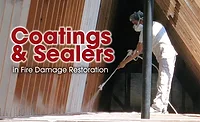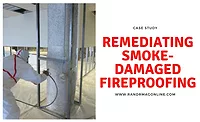Solutions by Sixes and Sevens: Smoke Sealers during Smoke Odor & Fire Damage Restoration

Coatings are an integral component of fire restoration, most crucially to prevent recurrence of smoke odor. Coatings implemented post-fire are not finish paints, yet do/can serve as primers: blocking stains and adhering to less than ideal surfaces. Those functions are valuable and fire-relevant, but alone insufficient for PRO Restoration. Fire damage sealers must primarily inhibit the release of fire-related odors days, weeks, months, and even years into the future. That is performance impossible for pedestrian primers. And to pile on, there are more attributes for coatings that fire restoration requires…
Do you really need to know this much about “paint” to succeed at fire damage? Yes and no. The aim here is to help professionals ask the right questions, and who to call for accurate information.
Even seasoned restoration professionals need better understanding. There is a confluence of confusion. New technology is rising up and forcing change to established practices. Education from oral tradition is graduating into eagerly anticipated guidelines, standards and certifications. Fragmentary regulation is inevitable, and like mold/lead/asbestos, there is talk of licensing. Contractors, large-loss consultants and training providers struggle continually to incorporate innovation and consistency.
Fire Coatings Education: A Situation at Sixes and Sevens
During Summer 2016, I conducted an informal survey by interview of many prominent training providers for fire damage restoration. We discussed what was said about sealers in class, on powerpoint slides, in manuals and on exams. The absence of consistency was astounding. The need for improvement on teaching fire damage chemistry ran the gamut from avoidance in class due to lack of information, but more seriously there is also information taught regularly despite being incorrect.
Instructors did share consensus that a., the current deficit of what they have to teach on coatings for fire is frustrating, and b., better current information on the choices of coatings would help prevent avoidable mistakes. The overall frustration was visceral enough to resemble actually emotional aggravation with a side of futility. The consensus among the trainers reminds of an old English expression for being confused, disoriented and uncertain: i.e., to be at “sixes and sevens”. Uncommon today on the left side of the Atlantic, this phrase is to throw up your hands in exasperation. That is the condition of being at Sixes and Sevens. It is an evocative phrase with quite a pedigree (Chaucer, Shakespeare, Madonna, Robert Plant, just to invoke from the past 600 years).
In the absence of a paint-by-numbers solution to our sixes-sevens situation with sealers for combustion residues and odors (see sidebar), this article proposes to start with sorting our types of coatings for fire into distinct categories, also sorting the FFB (features, functions, benefits) we need/want from these products, and then connecting the dots created.
Sealers vs. Encapsulants
Restoration professionals typically group their specialty coatings for fire damage restoration into a category labeled with the umbrella term sealers. Yet even in professional circles there are other popular category labels like encapsulants. As early as the 1970s, encapsulation has been in many nations a legally-codified practice of permanent abatement of asbestos and lead-based paint (alongside abatement by removal as a “management-in-place” alternative).
However, for fire damage restoration, the long-standing and understandable concern is that an encapsulation coating could be misunderstood and applied to manage fire contaminants in place rather than removing the contaminants first. As is common across restoration disciplines, for fire the proper procedure is to remove contaminants, and then the coating is applied among the final steps to complete the mitigation process. Since encapsulant conveys an inherent sense of applying over an undesirable substance rather than removal, the word itself can be at cross-purposes with arguably the most fundamental principle of restoration. Put another way, elimination of encapsulant/encapsulation from the fire restoration vocabulary will improve the standard of care by removing a source of misunderstandings. Pun intended: let’s stick with sealers.
Overall Sealer Limitations
The most common concern regarding the use of sealers involves overreliance on these tools instead of conducting source removal properly. Sealers can be useful and complementary tools to professionally-conducted contaminant removal, cleaning and deodorization.
When sealer use is intended, it is important that all materially interested parties concur that the agreed upon extent of cleaning and deodorization has been fulfilled. Thorough cleaning and odor removal performed before sealing is the most reliable way to prevent the reappearance of fire residues and odors. Ideally, an intensive visual and olfactory examination of the areas in question should be performed prior to the application of any sealer.
If a third-party consulting professional is engaged in the design and monitoring of the project, it should be required in the project scope that an opportunity is given for that entity to conduct an inspection (or PRV-Post Remediation Verification) before sealer application begins.
Fire Sealers Organizing the Data
The goal is by organizing the available data along an attributes axis on one hand, versus functions necessary to fire/smoke resolution on the other, what emerges is a matrix that clarifies the choices available: especially key capabilities and limitations. As it happens, there are six or seven sets of capabilities/limitations useful to this organization of information. Add some liberal alliteration, and the result is a memorable matrix that the restoration professional can quick-reference on demand.
In organizing types of sealers, there are four readily apparent categories:
- SHELLAC
- ALKYD
- WATER-BASED
- FIXATIVES
For performance attributes and limitations across these categories, (and this is where some mind-tickling alliteration gets deployed), there are at least six key categories for the other axis of an eventual performance attribute matrix:
- STICK
- SUPPRESS
- SEAL
- SELECTIVE
- SIMPLIFY
- SUSTAINABLE
Sealer Formulation Types
Understanding the attributes and limitations of the sealers available can in large part be organized by the type of chemical formulation.
Shellac
Shellac is a coating composed of processed lac resin (a secretion from an insect indigenous to areas in and surrounding India to Indonesia) dissolved into suspension in alcohol. Historically, this is the primary sealer type utilized in fire damage restoration with a legacy of successful application for fire odor control when used properly.
- Attributes:
- Readily available at retail paint stores and home centers
- Capable of application and curing at colder temperatures than other sealer formulation types (as low as 10°F)
- Excellent history of sealing in smoke odor from decades of use in fire restoration
- Adhesion to less than pristine substrate surface conditions
- Cured finish is much harder than other sealers
- Accepts most topcoats as a primer
- Dries rapidly (often less than 30 minutes)
- Excellent stain blocking
- Most expensive of the sealer formulation types with raw material insecurity causing ongoing trend in elevated product cost
- Limitations:
- Lacks flexibility
- Impermeable to transmission of water vapor (can trap moisture; form an unintended condensation layer/vapor barrier)
- Brittle if exposed to direct impact
- Unsuitable for exterior (outdoor) use [even with a topcoat]
- Can pose an ignition/fire hazard if off-gassing alcohol vapors accumulate in presence of ignition sources (pilot light, water/space heater, cigarettes, sparks)
- Meticulous cleanup with denatured alcohol exclusively (inadequate cleanup can result in irreparable damage to spray equipment
- Excess material disposal requires special handling by solvent recycling
- Pungent solvent (lacquer) odor that can persist for up to a week, and may require air scrubbing with carbon filtration to eliminate most but not all residual shellac odor
- Tightening regulations governing maximum volatile organic contents (VOCs) are making availability in certain areas problematic (e.g., available only in small container sizes) or completely unavailable
- PPE protection needed to protect from inhalation
Alkyd (Oil)-based Sealers
These are generally primers intended for the purpose of sealing stains such as from water intrusion into drywall, plaster. Also, primers for other stains are likely to migrate into finish coats if left unaddressed, such as: wood tannins, nicotine stains, etc.
- Attributes:
- Readily available at retail paint stores and home centers
- Can be the least-expensive of sealer formulation types
- Tolerates imperfect substrate surface conditions
- Excellent stain blocker
- Accepts most water and oil-based topcoats as a primer only after thorough curing
- Rapid drying
- Sands easily
- Limitations:
- Generally makes no performance claims regarding containment of fire/smoke-related odor
- Prior to application, separated components require extensive mixing to reincorporate into a uniform coating
- Lacks flexibility
- Flammable and/or combustible
- May need specialized handling for waste disposal
- Lengthy cleanup using mineral spirits reduces productivity, increased labor costs for downtime, and increases solvent exposures
- PPE protection needed to protect from inhalation
- VOC restrictions expected to curtail availability in sizes larger than one-gallon (4L)
- Persistent odor
- Permeability is uncertain
Water-based Sealers
This type of sealer involves acrylic polymer systems, potentially blended with additional specialty resins in a water-based vehicle designed to cure via coalescence. Group includes water-based products specifically formulated for fire damage restoration. Historically, there has also been use of water-based primers primarily formulated for sealing stains.
- Attributes
- Readily available at professional restoration distribution; to a lesser extent at retail paint stores and home centers
- Generally higher cost than alkyds, but less expensive than shellac
- Can be formulated to seal smoke odor but offering permeability to water vapor transference
- Highest flexibility among formulation types
- Formulations designed to be diluted can be effectively applied to spray-applied fireproofing
- Formulation type least likely to alter/affect UL Classification of fireproofing/firestop building components
- Least complicated cleanup procedures
- Can be tested for compliance to NFPA 90A/90B requirements in International Building Code (IBC) for application within the ductwork and components of HVAC systems
- Can be applied to fiberglass lined HVAC systems without destabilizing the liner material
- Formulation type offering least odor, and VOC/VOS content
- Generally formulation category requiring least pre-application mixing
- Most probable category applicable to spray-foam insulation without adverse effects to the foam and/or deterred adhesion of the sealer
- Formulation type most likely to be acceptable when sensitive occupants and environments are present
- Not combustible or flammable; safest to use when potential ignition sources are present
- No specialized handling for waste disposal
- No additional PPE requirements
- Formulation type least likely to have availability adversely affected by tightening environmental restrictions
- Limitations
- Less tolerant of imperfect substrate surface conditions; greater preparation required
- Drying/curing times can vary widely with some products offering rapid curing, but extended dry time for other versions
- Stain blocking performance is variable with some products effective in one coat, but some requiring two or more applications, especially for certain surface issues, such as rust.
- Cured films are typically softer than other formulation types
- May be deteriorated by topcoats with high solvent content (alkyd, epoxy, urethane)
- May not accept sanding prior to topcoat as well as other formulation types
- Not all formulations are universally applicable via brush, roller and airless spray
- Unlikely to provide a vapor barrier where one is desired
- Compatible with most caulk and foam, but may be repelled by high-silicone content
- Not applicable when ambient surface and air temperatures are below 45°F
Particulate Fixatives: Extremely low solids formulations designed to adhere residual particulates to surfaces, therefore isolating such contaminants from the respirable air. Will not alter surface appearance significantly as no tangible film is formed.
- Attributes
- Limitations
Notes from the Author:
- Sealer works well generally, but not in the HVAC environment. There, per the NADCA Chemicals and Coatings in HVAC Systems white paper (written with USEPA participation), a sealer is a coating intended to improve duct leakage and efficiency issues. Smoke sealers for HVAC application after fires would be included among Resurfacing Materials. AKA, repair coatings used as part of getting an element og an HVAC system back into a healthy and functioning condition.
Portions of this article were adapted from:
- ANSI/IICRC S520-2008, Second Edition, Reference Guide Equipment, Tools and Materials, pages 117 and 120.
- Sealer works well generally, but not in the HVAC environment. There, per the NADCA Chemicals and Coatings in HVAC Systems white paper (written with USEPA participation), a sealer is a coating intended to improve duct leakage and efficiency issues. Smoke sealers for HVAC application after fires would be included among Resurfacing Materials. AKA, repair coatings used as part of getting an element og an HVAC system back into a healthy and functioning condition.
- NIDR 10-8.3. 2002
- Adapted from ANSI/IICRC S520-2008, Second Edition, Reference Guide Equipment, Tools and Materials, page 177; and from NIDR 10-8.3, 2002
Looking for a reprint of this article?
From high-res PDFs to custom plaques, order your copy today!









